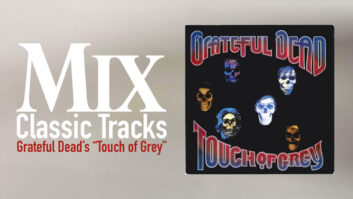Did you get your questionnaire from Apple and Microsoft about what audio/video-oriented features you wanted in their latest operating systems? Neither did I, so as usual, we cross our fingers that the next OS to which we upgrade will fix more things than it breaks. Sometimes we strike gold—Core Audio comes to mind—and sometimes we don’t (Windows 8, anyone?).

Now the Mac is up to OS X 10 (Yosemite), so thankfully people don’t refer to OS X as “OS 10” anymore, or we’d have “OS Ten Ten.” In further nomenclature silliness, Microsoft has skipped Windows 9 altogether, and is proceeding to Windows 10. I’m not making either of these up.
While OS X 10 is out, W10 remains in preview mode. But there’s a common theme: Mobile matters. Although OS X 10’s sexiest features relate to integration with iOS hardware, desktop/mobile application integration remains elusive—which is where Microsoft hopes to shine. The W10 team has more of a mobile orientation, and while that causes fear among some (“Windows will turn my desktop into a tablet!”), I’m cautiously optimistic. Mobile is hard to get right and is arguably easier to scale to a desktop than the reverse. If Windows can access mobile apps on your desktop, that’s a good thing—assuming anyone cares about mobile Windows apps.
But tablets may be a different matter because Windows tablets and notebook-type computers are striving for serious power, touch control, and cost-effectiveness—those commercials over Christmas showing a MacBook Air and Surface 3 were strong counters to yesteryear’s Mac vs. PC commercials. Of course the Mac hasn’t been asleep; the emphasis on “any-day-now-it’s-gonna-be-huge” Thunderbolt can greatly extend a laptop’s power. But it seems Microsoft sees a major opportunity in the schism between OS X and iOS to go one-up on Apple in the mobile world.
So Apple is parlaying its cachet into more interoperability, while Microsoft is attempting the integration that was slated for Windows 8. But the dark side of this force is hardware.
I know several people who automatically buy a new computer to run a new operating system; they start over rather than upgrade. On the Mac, upgrading is easy—Yosemite can upgrade over Mavericks—but upgrading from Windows 7 to Windows 8.1 requires re-installing your compatible programs. However, although some users report seamless Mac upgrades, others highly recommend starting over with a clean install.
There’s also controversy about OS X 10 “slowing down” machines (we’ll overlook the wi-fi issues for now). Dig deeper, and you’ll generally see that the older the Mac, the less happy the user. Granted, giving away an OS for free is not exactly a profit center, so you want people to upgrade their Apple hardware. Still, the myriad customer reviews have an uncomfortable number of “I regret upgrading” comments that offset at least some of the “works great!” verdict from those with newer machines.
Microsoft’s Upgrade Assistant advises if your hardware will do the job, and checks your applications too. But while most machines that run Windows 8.1 will run Windows 10, older processors that don’t support PAE, NX, and SSE2 are nonstarters (fortunately, if your computer is even relatively modern, you’ll be fine). Just don’t believe Microsoft’s rose-colored system specs. You need more RAM.
One of W10’s marquee features—a virtual desktop—isn’t new to Apple users. Those with longer memories will remember the Amiga’s Workbench, but in any event, it’s good Windows has caught up. What’s truly novel is Continuum, the technology that scales the OS to different devices. Unlike Windows 8, which tried to adapt the devices to the interface, Windows 10 adapts the interface to the devices. Microsoft is also making a big deal about Cortana, which seems to be like Siri but with a propensity for learning over time.
What remains to be seen is the business model. Windows 7/8 owners can get Windows 10 free during its first year. Will a subscription come after that, or will Microsoft continue the “rent it, own it, your choice” path they’ve taken with Office?
Looking at either OS, it’s clear the emphasis is on mobile integration—with Mac, to create interoperational links and with Windows, to scale a single user interface. You won’t see a raft of audio or video enhancements, but what you will see is both companies trying to remain relevant in an ever-changing world.
Author/musician Craig Anderton has given lectures on technology and the arts in 38 states, 10 countries, and 3 languages. Check out some of his music at youtube.com/thecraiganderton.







